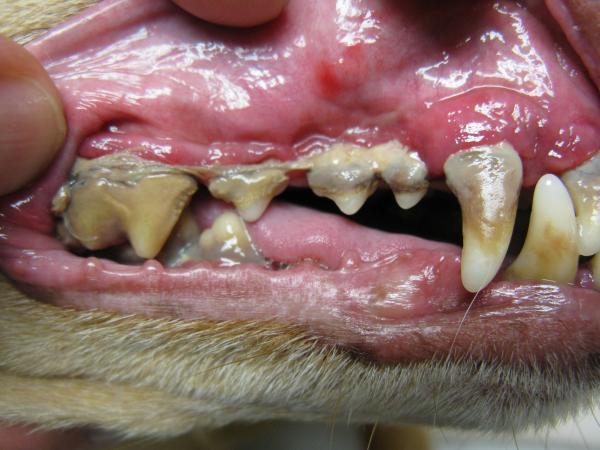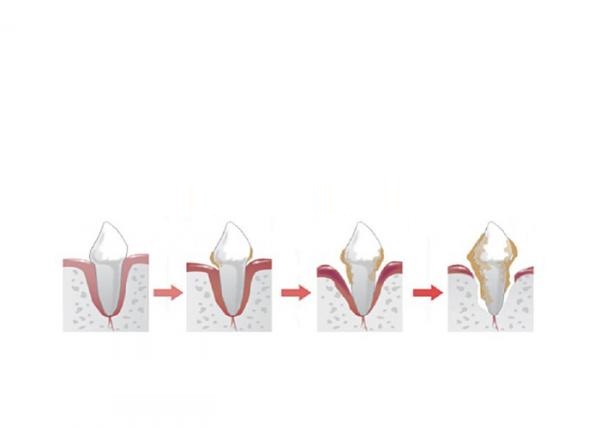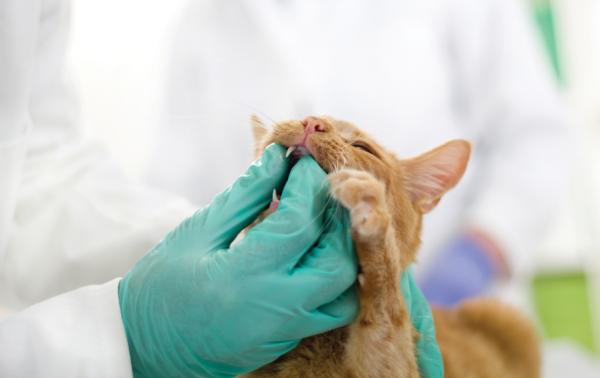Periodontal disease in cats – Treatment and prevention

Unfortunately, oral diseases in cats they are very frequent, mainly in adult and elderly individuals. One of the greatest threats to the oral health of our pigs is periodontal disease, which includes numerous infections that can affect the gums and the bone structure that supports the teeth.
If your cat has a lot of tartar or has abscesses in the mouth, these can be symptoms of Feline Periodontitis. Of course, we remember the need to quickly consult the veterinarian to find out the health status of your kitten and proceed with a correct diagnosis. However, in this new article, you will be able to know the main causes, symptom and the ways of treatment to Periodontal disease in cats, As well as its prevention.
What is periodontal disease?
Periodontal disease comprises various infectious pictures that generate a progressive inflammation in the bony and muscular structures that are around the teeth and give them lift. Currently, it is estimated that close to 80% of the feline population worldwide suffers from periodontitis. This disease is the main cause of tooth loss in adult cats and can severely threaten their health.

Causes of Feline Periodontitis
Like most dental problems, periodontal disease begins with the formation of bacterial plaques on the teeth and gums. When we do not brush the teeth of our cats well, the remains of food accumulate between the teeth and in the gums. These residues serve as food for the bacteria lodged in the cat’s mouth, which reproduce rapidly, forming plates.
As saliva comes in contact with these plaques, its minerals react with the enamel of the tooth and with the bacteria, forming the tartar. Then, the tartar adheres to the teeth and the bacteria continue to reproduce and feed, opening the way under the gums and causing a gingivitis (inflammation in the gums). When gingivitis is not treated quickly, Bacteria reach tissues and bones that support the teeth, causing periodontal disease.
Symptoms of Periodontal Disease in cats
Periodontal disease move quickly and silently, so it is essential to be aware of its first symptoms to allow an early diagnosis. Remember to periodically check the mouth of your pussycat and do not hesitate to go immediately to the vet in front of an unusual observation.
Clinical signs of feline periodontitis:
- Halitosis (bad breath).
- Bleeding and redness of the gums.
- Excessive drooling, which can be accompanied by blood.
- Difficulty chewing, which usually causes loss of appetite.
- Constant impetus to touch or scratch the mouth.
- Swelling of the mouth and face.
- Secretion in the nose.
When not treated quickly, periodontitis causes the recession of the gums, compromises the nerves and it leads to loss of the tooth. If the bacteria continue to advance and reach the bloodstream of the animal, can affect the heart, liver and kidneys, causing infections and eventual insufficiencies. In more advanced cases, periodontal disease can be lethal for cats, therefore, requires immediate attention from a veterinarian.
Remember that the fall of teeth of adult cats and the consequences that we have shown you of this dental disease in cats affect and compromise their well-being, as well as your lifestyle. If you suspect a disease in cats of the mouth, go to your trusted veterinarian.
Treatment of feline periodontitis
When observing any anomaly In the mouth of your cat, it will be essential to immediately consult the veterinarian of your trust. In the clinic, the professional will be able to verify the presence of tartar and gingivitis, in addition to requesting clinical analysis and X-rays to see the progress of the bacteria in the bone structure and in the organism. If diagnosis of periodontal disease is confirmed, the treatment will depend fundamentally on the severity of the infectious process in each animal.
Usually, they are administered Antibiotics specific to eliminate and control the progress of bacteria. The specialist can also recommend a feed for cats with gengivitis. When the disease is moderate and there is no loss of bone mass, a surgical intervention To remove tartar and dental polish are usually effective in reversing dental damage.
However, when periodontitis is more advanced, the tooth extraction It is usually inevitable, as well as the application of antibiotics below the gums. In addition, in severe cases, the treatment may also contemplate other organs affected by the bacterial infection.

How to prevent periodontal disease in cats?
To prevent your pussy from developing periodontal disease, it is essential to provide adequate oral hygiene throughout your life. This must necessarily include brushed newspapers with products suitable for cats. If you have never brushed your pussycat’s teeth or you want to learn how to do it correctly, discover in tips to clean a cat’s teeth. In addition, it is important to periodically check the mouth of your kitten and go quickly to the veterinarian when observing any alteration of color, unpleasant aroma, bleeding or the absence of any tooth.
You can also consult your veterinarian about the alternative change the dry feed of your cat for a raw diet or BARF. The natural feeding with fresh and raw products prevents the accumulation of residues in the teeth and facilitates oral hygiene of the cats. In addition to promoting digestion, the immune system and the metabolism of our pigs.
Remember also that all cats, whether mestizos or of a defined race, should receive an adequate preventive medicine during all his life. The visits every 6 months to the veterinarian, vaccination and deworming, a balanced diet and physical and mental stimulation are essential to strengthen the immune system of your pussycat and preserve your good health.
This article is merely informative, in .com we do not have the faculty to prescribe veterinary treatments or make any kind of diagnosis. We invite you to take your pet to the veterinarian in case of any type of condition or discomfort.
If you want to read more articles similar to Periodontal disease in cats – Treatment and prevention, we recommend that you enter in our section of Bacterial diseases.


